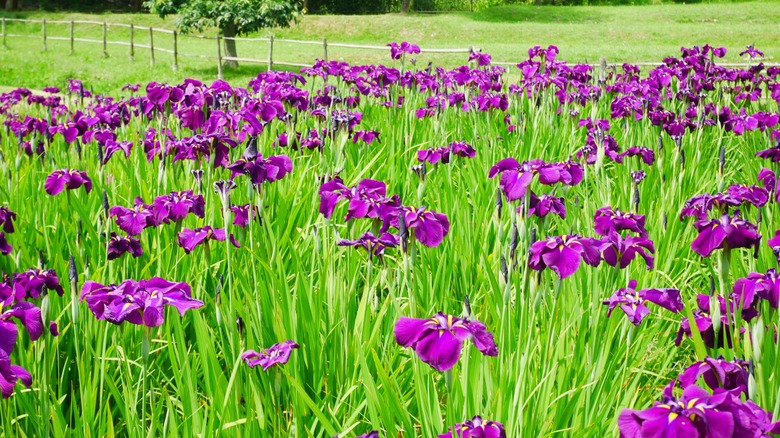When To Plant Japanese Iris For Flourishing Spring Blooms
There are several different types of iris to grow in the garden, including bearded German irises, Siberian irises, and Dutch irises. Japanese irises (Iris ensata), also known as Japanese water irises, are known for their large blooms, vivid colors, and suitability for damp areas. They are slightly more fussy than other types of iris, but when planted in a suitable location with the right soil conditions, they thrive and bloom beautifully year after year. The best time of year to plant Japanese irises is in early autumn.
Planting perennials in autumn gives them some time to establish themselves before cold temperatures set in or the ground freezes. Japanese irises like damp soil, so planting them before frost is a good idea to acclimate them to their new spot. Japanese irises do well in loamy soil and are suitable for areas where water tends to collect or where the ground stays damp in summer. The ideal situation is a spot that tends to be damp in spring or summer but less so in fall and winter.
Japanese irises make lovely perennials for water features and often do well planted next to a pond or marshy area. However, if the soil is too damp for them, the roots (technically rhizomes) may rot or turn mushy. If this happens, cut off the rotted parts and amend the soil with compost or other soil conditioners to improve drainage. It may take a couple of tries before you find the perfect spot, which can change yearly based on weather conditions. Be patient and observant; you will eventually find the perfect location for them.
Preparing to plant your Japanese irises
Once you've selected a good location, you're ready to plant your Japanese irises. Check the weather forecast and try to plant at least a month before the first frost date, if possible. If you are planting from divisions, remove any old roots that are long and dark-colored; the new roots are white. You should also cut the leaves back to two or three inches high. This will stimulate the roots a bit to help them get a good start.
Japanese irises like a slightly acidic soil, so adding some compost, peat moss, or used coffee grounds to the planting area is a good idea. Plant the root clump so that the crown (where the leaves begin) is two or three inches below the soil surface. If planting in a spot where there is standing water in summer, the crown of the plant needs to be above the water line. Japanese irises will increase in size relatively quickly, so give them some space to spread out. If planting individual roots, leave 6 to 8 inches of space; if planting a clump, give them 18 to 24 inches from each other and from other perennials.
Water the newly planted iris plants lightly every day for at least a week to help them get established. Japanese irises benefit from fertilization to add nitrogen to the soil but avoid feeding them with fertilizer until the following spring. Fertilizing them after planting in autumn may overstimulate the plants, and fertilizing newly planted perennials is not advisable. Divide and replant your Japanese iris in the fall every three or four years to keep them healthy and blooming at their best.

